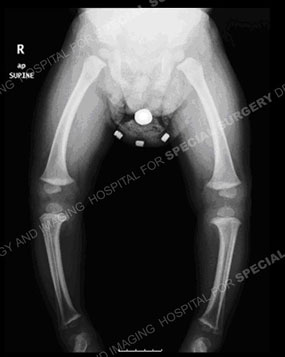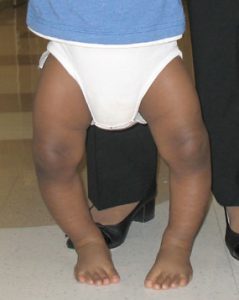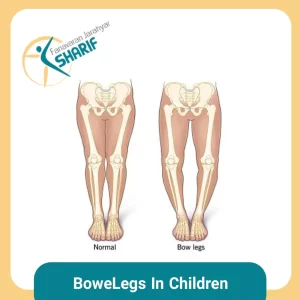Bowlegs is a condition in which a person’s legs appear bowed out, meaning their knees stay wide apart even when their ankles are together. Bowlegs is also known as congenital genu varum. Bowlegs can sometimes be a sign of an underlying disease, such as Blount’s disease or rickets, and may lead to arthritis in the knees and hips. Treatment options include braces, casts, or surgery to correct these bone abnormalities [1].
This condition is fairly common in infants because of their cramped position in the womb. Typically, no treatment is necessary for infants. A child’s legs will begin to straighten when they start to walk, usually between 12 and 18 months of age. In most cases, there are no lasting side effects. You should contact a doctor if your child has bowlegs beyond the age of 2.


What causes bowed legs in babies?
Bow legs develop for a number of different reasons. The most common cause of bow legs is a condition called physiologic genu varum. When the fetus was developing in your uterus, it was in a cramped position. Some of the fetal bones had to rotate while they were in your uterus so they could fit in the small space.
Physiologic genu varum is just your child going through the normal developmental process. If your child’s legs haven’t straightened by 2 years old, there may be another reason. These include:
- Blount’s disease. Blount’s disease (tibia vara) is a growth disorder caused by an issue in the growth plate of your child’s shin bone. Blount’s disease is more common in African American children, children who are overweight and children who walked early.
- Rickets. Rickets is caused by a calcium or vitamin D deficiency. Deficiencies in these important nutrients make your child’s bones softer and weaker, causing his or her legs to bow. Rickets is very rare in the United States but still occurs often in developing countries.
- Dwarfism. The most common type of dwarfism is caused by a bone growth disorder called achondroplasia. This disorder can cause bow legs.
- Other bone issues. Fractures that haven’t healed correctly and abnormally developed bones (bone dysplasia) can cause bow legs.
- Fluoride or lead poisoning.
What are the symptoms of bow legs?
The main sign of bowed legs is the appearance of your child’s legs. Their knees won’t touch when they stand with their feet and ankles together. The bowing is most obvious when they’re walking. Sometimes children may walk with their toes pointed inward (pigeon toes or intoeing).
However, bow legs usually don’t cause any pain. Bow legs don’t affect your child’s ability to crawl, walk or run. If your child’s bow legs don’t start to improve by age 2, contact your child’s healthcare provider.
How are bow legs corrected in babies?
No treatment is necessary in babies and toddlers unless the condition is severe. If bow legs continue after age 2, treatment depends on the cause of the condition. Treatment may include special shoes, splints, braces, casts, surgery or treatment of the condition causing the bow legs.
- Blount’s disease. Early treatment with a splint or leg brace may be all that’s needed.
- Rickets. Your child’s healthcare provider may treat your child’s condition by adding vitamin D and calcium to their diet. Your child’s healthcare provider may refer you to a specialist for treatment if the rickets is due to a genetic condition.
If bowing continues despite other treatments, surgery may be needed to prevent further damage and correct the issue. Surgery options include:
- Guided growth. With this procedure, your child’s surgeon will place a small metal plate or staple in your child’s leg. This will temporarily stop growth on the healthy side of the shin bone so the unhealthy side can catch up. Your child’s leg will straighten with their natural growth, and your child’s surgeon will remove the plate or staple once alignment has improved.
- Tibial osteotomy. With this procedure, your child’s surgeon cuts the shin bone below the knee and reshapes it to fix the alignment. While the bone heals, it’s held in place with a plate and screws inside the leg or a frame that’s positioned outside the leg.
Can bow legs be corrected naturally?
Treatment of bow legs depends on the cause of the condition. Early treatment options may include special shoes, splints, braces or casts.
References
- What Causes Bowlegs and How Is It Treated? William Morrison, Ann Pietrangelo. [Updated 2019 Aug 2],
Available from: https://www.healthline.com/health/bowlegs - Bow Legged, [Updated 2021 Nov 02]
Available from: https://my.clevelandclinic.org/health/diseases/22049-bow-legged

